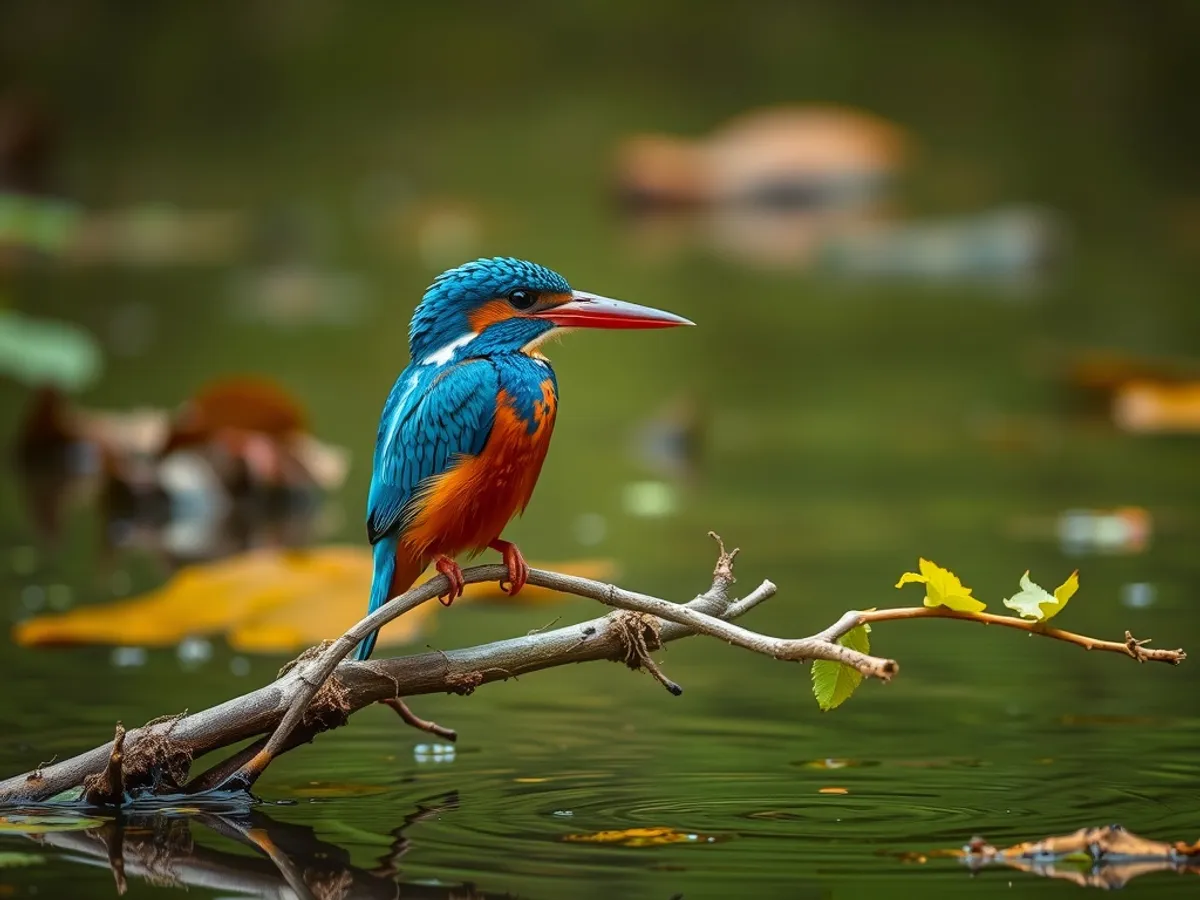
Azure Kingfisher
Ceyx azureus

Meet the Azure Kingfisher
The Azure Kingfisher is a small, brilliantly colored bird known for its vivid cobalt-blue upperparts and striking orange underparts. Found predominantly along freshwater rivers, streams, and billabongs in Australia and parts of New Guinea, this species is highly adapted for a life of fishing. It has a compact body, short tail, and a long, slender bill perfectly suited for catching aquatic prey. The Azure Kingfisher is shy and elusive, often spotted perched low over water, waiting patiently to dive for small fish and aquatic insects.
Classification
Bird
Habitat
Freshwater rivers and streams
Diet
Carnivore
Lifespan
6-10 years
Conservation
Least Concern
Weight
29–35 grams
📖Fascinating Facts
Expert Diver
The Azure Kingfisher dives headfirst into water with incredible speed to catch fish and aquatic insects, using its sharp, pointed bill.
Riverbank Nester
This bird typically nests in horizontal burrows that it excavates into riverbanks, providing safety from predators and flooding.
Vivid Plumage
Its intense blue and orange coloration serves both as camouflage among rippling water and vegetation and as a signal during courtship.
📋Detailed Description
The Azure Kingfisher (Ceyx azureus) is a diminutive, vibrantly colored kingfisher measuring 17–19 cm in length and weighing approximately 29–35 grams. It is characterized by deep cobalt-blue upperparts with a distinctive violet sheen, contrasting sharply with rich orange underparts and white throat patches. The bill is long, straight, and black, optimized for precision fishing, while the legs and feet are bright red to orange. The wings are short and rounded, facilitating rapid, direct flight over water. This species exhibits cryptic perching behavior, often sitting motionless on low branches or reeds close to water, making it difficult to spot despite its bright plumage. Its eyes are large and forward-facing, providing excellent binocular vision for detecting prey beneath the water’s surface. The Azure Kingfisher is generally solitary or found in pairs, maintaining linear territories along watercourses. It is highly territorial, using vocalizations and aerial chases to defend its stretch of riverbank. Reproduction involves excavating nesting burrows in riverbanks, and both sexes participate in incubation and chick rearing. The species is known for its rapid, shallow dives and remarkable agility in flight, adaptations that support its piscivorous lifestyle.
💡 Did you know?
Despite being called a kingfisher, the Azure Kingfisher rarely eats kingfish and is more reliant on small fish, crustaceans, and aquatic insects.
🔬Research & Sources
Wikipedia Summary
The azure kingfisher is a small kingfisher in the river kingfisher subfamily, Alcedininae.
Last Modified: 10/28/2024
🎭Behavior & Social Structure
Azure Kingfishers are primarily crepuscular, with peak activity at dawn and dusk, though they may hunt throughout the day in shaded or overcast conditions. Their hunting strategy involves perching quietly 1–2 meters above water, scanning for movement before plunging headfirst to seize prey with their bills. Diet consists mainly of small fish (up to 4 cm), aquatic insects, crustaceans, and occasionally tadpoles. After catching prey, the bird returns to its perch to subdue and swallow it whole, often beating fish against the perch to immobilize them. Socially, Azure Kingfishers are territorial and largely solitary outside the breeding season, with pairs maintaining exclusive stretches of riverbank. Vocalizations include sharp, high-pitched 'tsee' or 'tik-tik' calls, used for territory defense and mate communication. They are generally shy and will quickly retreat into dense vegetation if disturbed.
👶Reproduction & Life Cycle
Breeding occurs from August to February in Australia, with timing influenced by rainfall and water levels. Courtship involves aerial displays and mutual feeding. Both sexes excavate a horizontal burrow, 50–100 cm long, in a sandy or clay riverbank, ending in a nesting chamber. The female typically lays 4–7 glossy white eggs, which are incubated by both parents for 18–21 days. After hatching, both adults feed the chicks, which remain in the nest for 20–26 days before fledging. Parental care continues for up to two weeks post-fledging, during which time the young learn to hunt. Azure Kingfishers may raise two broods per season if conditions are favorable.
🛡️Adaptations & Survival
The Azure Kingfisher exhibits several specialized adaptations for its aquatic lifestyle. Its streamlined body and short tail reduce drag during rapid dives. The long, pointed bill allows for efficient spearing and grasping of slippery prey. The eyes possess a high density of rod cells and a nictitating membrane, enabling sharp underwater vision and protection during dives. The feet are syndactyl (two or more toes fused), aiding in perching on narrow branches. Plumage is highly water-resistant due to specialized feather microstructure and preen oil. Behavioral adaptations include cryptic perching to avoid predators and rapid, low flight over water to escape threats.
🎨Cultural Significance
The Azure Kingfisher holds a modest place in Australian Aboriginal folklore, often symbolizing agility, alertness, and the spirit of waterways. Its striking appearance has made it a subject of birdwatching interest and eco-tourism, particularly in eastern Australia. The species is occasionally featured in local art and literature as an emblem of pristine riverine environments. There are no known traditional uses or significant roles in mythology beyond its symbolic association with water and purity.
🔬Recent Research & Discoveries
Recent studies have focused on the Azure Kingfisher’s response to habitat fragmentation and water quality changes, with findings indicating a strong dependence on intact riparian corridors for breeding and foraging. Genetic research has revealed subtle differentiation among subspecies, particularly between Australian and New Guinean populations, suggesting historical isolation and local adaptation. Ongoing research is examining the impact of climate variability on breeding phenology and chick survival. Acoustic monitoring is being used to assess territory occupancy and population trends in remote habitats. The species is also used as a bioindicator for freshwater ecosystem health due to its sensitivity to water quality and prey abundance.
🎥Wildlife Videos

THE AZURE KINGFISHER - DOCUMENTARY
Thanks for tuning in to the last short documentary of the AZURE KINGFISHER. To capture this footage, I have had to crawl through ...
Tim Henry's natural & wild world

The Azure Kingfisher documentary trailer
Welcome to the trailer video to The Azure Kingfisher, this was originally going to be a one-off documentary but I had so much ...
Tim Henry's natural & wild world

Azure Kingfisher
The Azure Kingfisher inhabits freshwater and saltwater creeks and rivers. They can be seen bobbing their heads while perched ...
Tim Siggs

Saving A BEAUTIFUL Azure Kingfisher
I saved this beautiful azure kingfisher and let him free! #beautifulbirds #kingfisher #australianbird #nature #birds Follow CrittaCam ...
CrittaCam

YARRA VALLEY | Photography challenge to find Azure Kingfishers
SEPTEMBER 2022 In this video, we take you out to the beautiful Yarra Valley to find Azure Kingfishers. The Azure Kingfishers are ...
Nature Photography Challenge

Kingfishers - The Gift of Nature (flying rainbow) | Go Wild
The Oriental Dwarf Kingfisher is one of the most enigmatic and rarely filmed birds in the world. This fascinating documentary ...
Go Wild
🌍Habitat Information
The Azure Kingfisher typically inhabits Freshwater rivers and streams environments. Azure Kingfishers have adapted to their environments with specialized features and behaviors.
Primary Habitat:
Freshwater rivers and streams
More detailed habitat information will be available soon.
🛡️Conservation Status
The Azure Kingfisher is currently classified as Least Concern. Conservation efforts are crucial for preserving this species for future generations.
Common Threats:
- 🏠Habitat loss and fragmentation
- 🌡️Climate change impacts
- 🎯Hunting and poaching
- 🏭Human-wildlife conflict
⚠️Threats & Conservation Challenges
While currently listed as Least Concern by the IUCN, Azure Kingfishers face localized threats from habitat degradation, particularly the clearing of riparian vegetation, bank erosion, and water pollution. Alterations to river flow, damming, and water extraction can reduce prey availability and nesting sites. Invasive species such as feral cats and rats may prey on eggs and chicks. Climate change poses long-term risks through altered rainfall patterns and increased frequency of droughts or floods, potentially impacting breeding success. Despite these challenges, the species remains widespread and relatively stable across its range, though some local populations may be in decline.
🔬Scientific Classification
Scientific Name
Ceyx azureus
Classification Hierarchy
🔍 About Taxonomic Classification
Taxonomic classification is a hierarchical system used by scientists to classify and organize living organisms based on shared characteristics and evolutionary relationships.
The system moves from broad categories (Kingdom) to increasingly specific ones, with each animal's scientific name typically consisting of its Genus and species.
📝Community Notes
Share your observations and insights about the Azure Kingfisher with our community of wildlife enthusiasts.
Join Our Community
Sign in to share your observations and connect with fellow wildlife enthusiasts.
Sign In to ContributeNo community notes yet
Be the first to share your observations about the Azure Kingfisher!
Explore Azure Kingfisher
Select a tab above to learn more about this amazing animal.
📸Photo Gallery
No photos available for this animal yet.
🌟Discover More Wildlife
Continue your journey of discovery with more fascinating animals from our database
